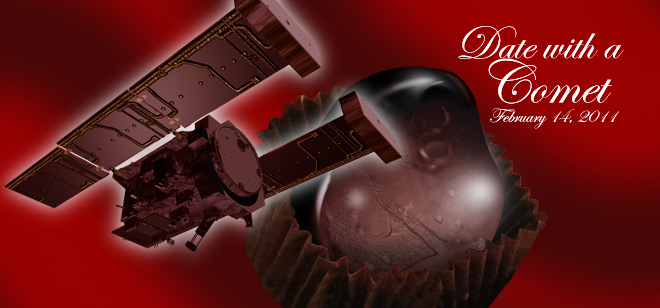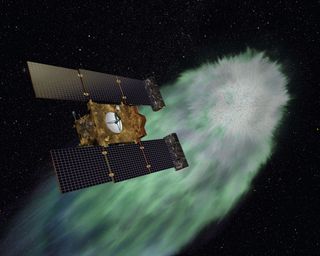
No matter how elaborate some couples' Valentine's Day plans may be, they can't hold a candle to tonight's cosmic date between a comet and a NASA probe.
After more than three years of preparation, NASA's Stardust-NExT spacecraft will fly to within 124 miles (200 kilometers) of comet Tempel 1 tonight (Feb. 14), at around 11:40 p.m. EST (0440 GMT on Feb. 15). The mission's main goal is to see how much Tempel 1 has changed since July 2005, when NASA's Deep Impact probe smashed an impactor into the comet's surface.
"Deep Impact discovered that this is a most interesting comet," said Stardust-NExT principal investigator Joe Veverka, of Cornell University, in a recent NASA video. "We want to see more of the surface, and we also want to see what changes have occurred since Deep Impact was there five years ago."
Two-timing spacecraft, two-timing comet
Like comet Tempel 1, Stardust-NExT is an old hand at this sort of encounter. The probe began its life as the Stardust spacecraft, which launched in February 1999 on a mission to collect dust and gas from around comet Wild 2 and send the sample back to Earth.
Stardust completed the mission successfully back in 2006, when its comet sample return canister landed in the Utah desert. Since the orbiting spacecraft was still in good shape and had a fair bit of fuel left, NASA gave it a new mission in 2007 — to rendezvous with Tempel 1.
The probe was rechristened Stardust-NExT (for "New Exploration of Tempel").
Get the Space.com Newsletter
Breaking space news, the latest updates on rocket launches, skywatching events and more!
The bonus mission is a bargain, NASA officials have said, since it takes advantage of an asset already in space. It cost about $300 million to launch and operate Stardust through the end of its primary mission. Stardust-NExT's total cost, on the other hand, should be just $29 million.
Tempel 1 is a 3.7-mile-wide (6 km) comet that takes 5 1/2 years to make a trip around the sun. It was first discovered in 1867 and observed on a few return trips to the inner solar system thereafter. But it was then "lost" for decades, with attempts to spot it failing repeatedly.
In the 1960s, the late comet hunter Brian Marsden studied Tempel 1's disappearance and predicted it would return in 1967 and 1972. Those predictions were borne out, and astronomers got a good bead on the comet and its orbit.
In 2005, NASA's Deep Impact mission slammed an impactor into Tempel 1's surface, then studied the ejected material to get an idea of what the comet is made of. Deep Impact itself went on to rendezvous with another comet this past November, the chicken-drumstick-shaped Hartley 2.

Stardust-NExT's mission
Researchers hope Stardust-NExT will give them an idea of how Tempel 1 has changed in the five-plus years since Deep Impact's visit. The comet has made one orbit of the sun since then.
Scientists also hope to get a good look at the crater Deep Impact gouged out; the previous mission was not able to see it well, as the huge cloud of ejected debris obscured the new feature. Another aim is to extend geologic mapping of Tempel 1's surface, adding to the work done by Deep Impact.
Through making these and other observations, Stardust-NExT can contribute to scientists' understanding of how comets formed at the solar system's birth 4.6 billion years ago and how they have evolved since then, researchers have said.
"Comets can be very spectacular when they come close to the sun, but we still don't understand them as well as we should," Veverka said in a statement. "They are also messengers from the past. They tell us how the solar system was formed long ago, and Stardust-NExT will help us understand how much they have changed since their formation."
The flyby
At a little before midnight EST tonight, Stardust-NExT — traveling at about 24,300 mph (39,100 kph) — will come within 124 miles (200 km) of Tempel 1. The close encounter will take place about 209 million miles (336 million km) from Earth, researchers have said.
Stardust-NExT will take 72 high-resolution images during the flyby and begin transmitting them to Earth about an hour after the closest approach, researchers said. The pictures should all be in scientists' hard drives by about 12 hours after the flyby.
NASA will air live coverage of the comet encounter — including commentary from mission control at the Jet Propulsion Laboratory (JPL) in Pasadena, Calif. — on the space agency's website, and on NASA TV:
http://www.nasa.gov/ntv.
Stardust-NExT is a survivor, having already logged about 3.5 billion miles (5.7 billion km) in space. But this should be the last comet encounter for the probe, since it will burn up almost all of its remaining fuel chasing down Tempel 1.
The probe's last hurrah should be productive, researchers said, helping astronomers probe some of the mysteries comets still keep locked up tight.
"These are exciting things — they're all different," said Stardust-NExT project manager Tim Larson of JPL. "Every time we go near one, we find something new. And the opportunity for discovery is absolutely momentous."
You can follow SPACE.com senior writer Mike Wall's coverage of Stardust-NExT's comet flyby on Twitter: @michaeldwall. Follow SPACE.com's comet coverage at @SpaceDotCom and on Facebook.
Join our Space Forums to keep talking space on the latest missions, night sky and more! And if you have a news tip, correction or comment, let us know at: community@space.com.

Michael Wall is a Senior Space Writer with Space.com and joined the team in 2010. He primarily covers exoplanets, spaceflight and military space, but has been known to dabble in the space art beat. His book about the search for alien life, "Out There," was published on Nov. 13, 2018. Before becoming a science writer, Michael worked as a herpetologist and wildlife biologist. He has a Ph.D. in evolutionary biology from the University of Sydney, Australia, a bachelor's degree from the University of Arizona, and a graduate certificate in science writing from the University of California, Santa Cruz. To find out what his latest project is, you can follow Michael on Twitter.










